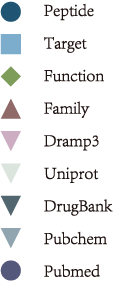Beauvericin
Basic information
| CPKB ID | CP00048 |
| IUPAC Name | 3,9,15-tribenzyl-4,10,16-trimethyl-6,12,18-tri(propan-2-yl)-1,7,13-trioxa-4,10,16-triazacyclooctadecane-2,5,8,11,14,17-hexone |
| Synonyms |
|
| Source |
Fusarium avenaceum [Division : Plants and Fungi]
Taxonomy :40199 (Fungi-Ascomycota-Hypocreales-Sordariomycetes-Nectriaceae Fusarium) Wikipedia: Fusarium avenaceum Fusarium sporotrichioides [Division : Plants and Fungi]
Taxonomy :5514 (Fungi-Ascomycota-Hypocreales-Sordariomycetes-Nectriaceae Fusarium) Wikipedia: Fusarium sporotrichioides Fusarium equiseti [Division : Plants and Fungi]
Taxonomy :61235 (Fungi-Ascomycota-Hypocreales-Sordariomycetes-Nectriaceae Fusarium) Wikipedia: Fusarium equiseti PubChem |
| Family | |
| Function | |
| Information |
3,9,15-Tribenzyl-4,10,16-trimethyl-6,12,18-tri(propan-2-yl)-1,7,13-trioxa-4,10,16-triazacyclooctadecane-2,5,8,11,14,17-hexone is a natural product found in Fusarium avenaceum, Fusarium sporotrichioides, and Fusarium equiseti with data available. 3-[(4-Hydroxyphenyl)methyl]-2,3,6,7,8,8a-hexahydropyrrolo[1,2-a]pyrazine-1,4-dione is a natural product found in Microdochium nivale and Alternaria alternata with data available. 7-aminoactinomycin D is a chromopeptide. It has a role as a fluorochrome. |
Legend

Structure
| Molecular Formula |
C45H57N3O9 |
| Molecular Weight | 783.4094804 g/mol |
| SMILES | CC(C)C1OC(=O)C(Cc2ccccc2)N(C)C(=O)C(C(C)C)OC(=O)C(Cc2ccccc2)N(C)C(=O)C(C(C)C)OC(=O)C(Cc2ccccc2)N(C)C1=O |
| InChI | InChI=1S/C45H57N3O9/c1-28(2)37-40(49)46(7)35(26-32-21-15-11-16-22-32)44(53)56-39(30(5)6)42(51)48(9)36(27-33-23-17-12-18-24-33)45(54)57-38(29(3)4)41(50)47(8)34(43(52)55-37)25-31-19-13-10-14-20-31/h10-24,28-30,34-39H,25-27H2,1-9H3 |
| InChIKey | GYSCAQFHASJXRS-UHFFFAOYNA-N |
|
2D Structure
PubChem|105014
|
|
|---|
Sequence
| IUPAC Condensed | cyclo[DL-OVal-DL-N(Me)Phe-DL-OVal-DL-N(Me)Phe-DL-OVal-DL-N(Me)Phe] |
| Amino acid chain | DL-OVal(1)--DL-N(Me)Phe--DL-OVal--DL-N(Me)Phe--DL-OVal--DL-N(Me)Phe(1) |
| Graph representation | DL-OVal,DL-N(Me)Phe,DL-OVal,DL-N(Me)Phe,DL-OVal,DL-N(Me)Phe @0,5 |
| Amino acid chain from Structure | Ac-Phe(1)(2)--Ac-Phe(1)(3)--Ac-Phe(2)(3) |
| svg Image |
Structure Properties
| Property Name | Property Value | |
|---|---|---|
| Exact Mass | 783.4094804 | |
| Number of Rings | 4.0 | |
| Complexity | 0.403508772 | |
| XlogP3 AA | 4.9125 | |
| Heavy Atom Count | 57.0 | |
| Hydrogen Bond Donor Count | 0.0 | |
| Hydrogen Bond Acceptor Count | 9.0 | |
| Rotatable Bond Count | 9.0 |
| Property Name | Property Value | |
|---|---|---|
| Formal Charge | 0.0 | |
| Refractivity | 214.266 | |
| Rule_of_Five | 0.0 | |
| Number of Atoms | 57.0 | |
| Topological Polar Surface Area | 139.83 | |
| Refractivity | 214.266 | |
| Veber Rule | 1.0 | |
| Ghose Filter | 0.0 |
| Property Name | Property Value | |
|---|---|---|
| RDKit Fingerprint |
00100000101010000100110001110001100000100001100000101000100101010000001110010000000100000010110011010101100001111011001001110110000001101010000000000111000010010110001110011110110111001011000101101000001111001000000101001010000011000101001101000100010001000110011110001000000000000111001100000111010000001100100111100011110100110110110011000110001001100011010000100001000000000000010000000001000000000110000100001110001001010000101101110011111100101000000100000011101110110000010000000000000110011000010000101101000101000100010000010101100011010100100010011111001011000000010001101000000000010100111001010000000010010010000000001110100101000100001000101101010001000100001010100001011001001100011000101000100111100010010000110010000001000101100110010010111100101011001110010000101001011001010010000000001000001000100010111001111001111000101011100110010000111101000111000001000100100100101001101010111001100011110101010101000110010110000000011001101000001000011011010000011000110110100000010000010100010010000001000101001111100111000100011011110000101100010000111100101010000001011001000001100000000001001001000010000000110000100100001000000101000100101001101000000010101100101101011001010010010011001101100000010001000001010011100010011001000011000011010010000001001100010000010000100110010001110001101011010011100001000001001110000011000011111010101000010111100011000000100010000101001010011100000111100001001101110010100101100011101010010011100100001011111011010100000110000011001001000000000101010100000000100010111011000000000000000000010110011110100100000000000001101100000110001000001001100010000001000011000011110000001010011000100010000000010010010100001100000001000100000010010000000001000001011010000000000111000010000110101000101000000001111000010100000001000110101010001100100001010010000010001010101101101000011011110010010110010011100011000000000000000001110011000010000100011100010100101111101101001011010000000101000000110001111100010001011010011011001001000001001111100110100101001000000110010110100001000100100000001111101001011001 |
|
| Morgan Fingerprint |
0100010000000000000000000000000001000000001000000000000000000000100000000000000010001000000000100000000000000000000000000100000000000000000000000000000000000000000000000000000100000000000000000000000000000000000000000000000000000000000000000000000000000100000000000000000000000000000100000000000000000000000000000010000000000000000000000000000000000000000010000000000000000000000000000000010000000000000000000000000000000000000000001000000000000000000000000010000000000000000000000000001000000000000000000000000010000000000000000000100000000000000000000000000000000000000000000000000000000000000000000000000001000000000000000000010000000000000000000010000010000000000000000001000000000000000000000000000000000000000000000000001001100000000000000000001000000000000000000000000000000000000000000010000000000000000000000000000000000000000000000000000001000000000000000000000000000010000000000000000000000000000000000000000000000000000000010000010000000000000000000000000000000000000000000000000000000000000000000000000000010000 |
|
| MACCS Keys |
00000000000000000000000000000000000000000000000000000000010000000000000010110000000001000000110100000000000000110000110011110101000000001100111101101110101111111111110 |
Biologic Description
Toxicity PubChem|105014
Beauvericin is cytotoxic and increases ion permeability in cell membranes by forming complexes with essential cations (Ca2+, Na+, K+) and by forming cation-selective channels in lipid membranes. This may affect ionic homeostasis, increasing the intracellular calcium concentration, and lead to apoptosis. Beauvericin is also genotoxic and causes DNA damage, either by directly forming DNA adducts, through increased intracellular calcium levels influencing endonuclease activity, or through oxidative stress. Beauvericin induces lipid peroxidation and production of reactive oxygen species, producing cytotoxic effects and immunosuppressive activity. In addition, beauvericin is a potent inhibitor of the acyl-CoA:cholesterol acyltransferase (ACAT), which plays an important role in cholesterol ester accumulation in atherogenesis and in cholesterol absorption from the intestine. In isolated terminal ilea and heart muscles of guinea pig, beauvericin decreases the contractility, shortening the action potential duration and depolarizing the membrane resting potential. Beauvericin is also known to inhibit certain cytochrome P-450 enzymes. (A3015, A3016, A3017, A3018, A3077)
Metabolism PubChem|105014
Free toxin may be removed by opsonization via the reticuloendothelial system (primarily the liver and kidneys) or it may be degraded through cellular internalization via the lysosomes. Lysosomes are membrane-enclosed organelles that contain an array of digestive enzymes, including several proteases.
Manufacturers
| Manufacturers Name | Value | |
|---|---|---|
| CreativePeptides | ||
| Bayer healthcare pharmaceuticals | ||
| Upsher smith laboratories | ||
| Merck |
| Manufacturers Name | Value | |
|---|---|---|
| Apotex | ||
| Baxter Healthcare Corp | ||
| Pharmasources | ||
| Novartis | ||
| AstraZeneca |
Forecasting tools
| Forecasting tools | Value | |
|---|---|---|
| Structure to Sequence | ||
| Structure Properties | ||
| Expasy ProtParam Tool | ||
| SEA | RUN SEA Predictions |
Information Source
| Property Name | Property ID | |
|---|---|---|
| Patents | GYSCAQFHASJXRS-UHFFFAOYNA-N | |
| pubchem | 105014 | |
| Drugbank | ||
| DRAMP3 | ||
| Uniprot | ||
| Cybase | ||
| NORINE | NOR00252 | |
| CONOSERVER | ||
| BindingDB | ||
| CHEMBL | CHEMBL1977672 | |
| CTD | ||
| Wikipedia | Beauvericin | |
| KEGG Compound/Drug | C11590 | |
| CHEBI | GYSCAQFHASJXRS-UHFFFAOYNA-N | |
| EPA DSSTox | ||
| FDA Global Substance Registration System (GSRS) | ||
| DTP/NCI | ||
| Chemspider | GYSCAQFHASJXRS-UHFFFAOYNA-N |
Reference
| Pubmed_ID | Title | DOI | Journal | |
|---|---|---|---|---|
1361546 |
10.1111/j.2042-7158.1992.tb03245.x. | J Pharm Pharmacol |
||
Brain as an eliminating organ?Abstract
|
||||
1681894 |
None |
Physiol Res |
||
Social recognition in male rats: age differences and modulation by MIF-I and AlaptideAbstract
|
||||
1687590 |
10.1111/j.2042-7158.1991.tb03200.x. | J Pharm Pharmacol |
||
Pharmacokinetics and brain entry of alaptide, a novel nootropic agent, in mice, rats and rabbitsAbstract
|
||||
1687863 |
None |
Homeost Health Dis |
||
Effects of MIF-1 and its cyclic derivative alaptide on agonistic behaviour in miceAbstract
|
||||
